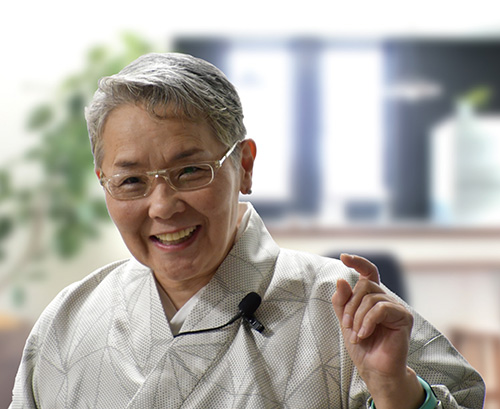
Kojiya Woman: Myoho Asari

浅利 妙峰
Myoho Asari was born in 1952 in Saiki in Oita Prefecture, as the eldest daughter of the Asari family, owners of a koji shop for eight generations.
As a child she was interested in other countries and cultures and was active in Girl Scouts which she credits for instilling in her a strong work ethic, teaching her good problem solving skills and the importance of teamwork.
The Girl Scouts’ motto “Be prepared” has become Myoho’s motto for her life. She is always anticipating the next situation and works to ensure that she is ready for whatever comes her way.
In 1970, the year of Osaka Expo, a high school junior, she participated in her first Girl Scouts’ International Camp where she met many ‘sisters’from all over the world and felt very close to them.
In 1974 after graduating from Tokyo Fuji Junior College, she participated in Girl Scouts Plymouth Camp as a Japanese camp couselor. There she was immersed with English and mastered speaking English. After traveling to Mexico, Miami, and San Diego she returned to her hometown and assisted her family’s business.
However, Saiki Kojiya, like koji shops all over Japan, was struggling to stay in business.
After the end of World War II, the eating habits of Japanese people changed and fewer people were making miso at home, thus eliminating the need to buy koji.
Saiki Kojiya had scaled back the size of their operation, but it was still difficult to make a profit. In order to keep the koji business going, they ended up branching out and began selling other items such as cardboard boxes for bentos, ice and dry ice.
In 1978, Myoho married and while she raised her 5 children, her parents continued to run Kojiya.
From 1989, she ran a tutoring center for elementary and junior high school students. She continued to be involved in scouting and was a troop leader for many years.
The turning point came in 2006. Her father who had kept things running became ill and they needed to decide what to do with the business.
Myoho’s second son had expressed an interest in eventually taking over the business, but although they were pleased he was interested, they didn’t feel that it was a viable option because the business was continuing to decline.
Not willing to give up, Myoho and her husband began researching, met with consultants and took classes. They explored ways to develop new products using koji.
In 2007 when Myoho’s mother passed away, the operation of the business was handed over to Myoho.
She continued to research and discovered in old texts from the Edo Period that salt was used with koji in pickling vegetables.
Working from that information she made shio-koji and started selling it in Saiki. Shio-koji became a local hit and received a lot of attention in the media.
Many people advised them to obtain the rights to the production of shio-koji, but they decided against it.
Shio-koji is easy to make and Myoho had a dream that people all over Japan would become interested in making their own shio-koji and that this could help turn the tide against the steady decline of koji shops across Japan.
She envisions shio-koji becoming as essential an ingredient as soy sauce in Japanese cooking.
In order for this to happen, she realized that she needed to spread the word about how shio-koji can be used in all types of cooking and to work hard to promote koji products.
She has adopted the moniker “Kojiya Woman” and offers cooking classes, has written cookbooks and has been on featured on national TV. Now she is looking towards spreading the word outside Japan to the rest of the world. “Salt is used in all cuisines of the world, I want shio-koji also to be used around the world.” She believes in the potential of koji and is earnestly pursuing their dream.


